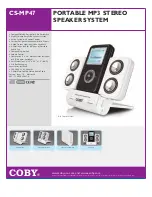
Amate Electroacústica,s.l.
MA206/MAW115.Version 1.3
Nov 08
5
Sound engineers use line arrays to obtain narrow directivities on the vertical plane. For
configurations with many cabinets (big height) and at high frequencies it is not unusual
to achieve narrow angles- in some cases they may be grade fractions. This can be
useful in venues where both a high sound pressure level and long throw are required;
nevertheless, this means less coverage of the audience area.
It is sometimes useful to achieve an asymmetrical coverage pattern on the vertical
plane, which can be obtained by aiming some of the cabinets through their hinging
points. We are now ready to define the last two criteria of "arrayability".
4) For curved arrays, the tilt angles should vary in inverse proportion to the listener
distance (this is geometrically equivalent to shaping variable curvature arrays to
provide equal spacing of individual element impact zones).
5) There are limits given the vertical size of each cabinet and their relative tilt angles.
In our case the maximum angle between cabinets is 8º .
Fig.4.
Tilt angle between cabinets (8º maximum)
1.3.Fresnel Region (Near Field) and Fraunhofer Region (Far Field)
If our system is able to fulfil the previous conditions it will produce cylindrical waves to
a maximum frequency. The wave will be flat up to a certain distance where it will start
to become spherical (depending on the frequency and the size of the array).
The limit distance between the zone of cylindrical waves (Fresnel) and spherical
waves (Fraunhofer) can be calculated through the following formula
2
2
3
1
1
2
3
⎟⎟
⎠
⎞
⎜⎜
⎝
⎛
−
=
Hf
f
H
d
c
where
d
c
= limit distance between near field and far field (in metres)
H = height of the array (in metres)
f= frequency (in kHz)






































